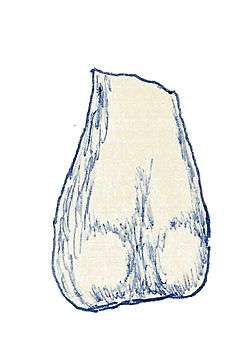Fulgurotherium
Fulgurotherium (meaning "Lightning beast") is the name given to a genus of ornithischian dinosaur from the Late Cretaceous (Cenomanian) Griman Creek Formation. It lived in what is now Australia.
| Fulgurotherium | |
|---|---|
 | |
| Femur fragment | |
| Scientific classification | |
| Kingdom: | |
| Phylum: | |
| Class: | |
| Superorder: | |
| Order: | |
| (unranked): | |
| Genus: | †Fulgurotherium von Huene, 1932 |
| Binomial name | |
| †Fulgurotherium australe von Huene, 1932 | |
The type species, Fulgurotherium australe, was named by Friedrich von Huene in 1932.[1] The genus name is derived from Latin fulgur, "lightning", and Greek therion, "beast", a reference to the Lightning Ridge site in New South Wales. The specific name means "southern" in Latin. The holotype is BMNH R.3719, the opalised lower end of a femur, indicating a total body length of 1 to 1.5 metres.
Von Huene thought it was a theropod, a member of the Ornithomimidae.[2] It has later been described as a hypsilophodont, a primitive ornithopod.[3] However, this was based on a contentious reference of bones found in the Dinosaur Cove, leading to a possible confusion between multiple species of Euornithopoda. Most researchers today consider it a nomen dubium.
Its name is an unusual example of a name in which -therium was used for an animal which is not an extinct mammal.
References
- F. v. Huene, 1932, "Die fossile Reptil-Ordnung Saurischia, ihre Entwicklung und Geschichte", Monographien zur Geologie und Palaeontologie, serie 1 4(1-2): 1-361
- F. v. Huene, 1944, "Aussichtsreiche Fundgegenden für künftige Sauriergrabungen", Neues Jahrbuch für Geologie und Paläontologie Monatshefte, Abteilung B 88: 441-451
- R. E. Molnar and P. M. Galton, 1986, "Hypsilophodontid dinosaurs from Lightning Ridge, New South Wales, Australia", Géobios 19(2): 231-239